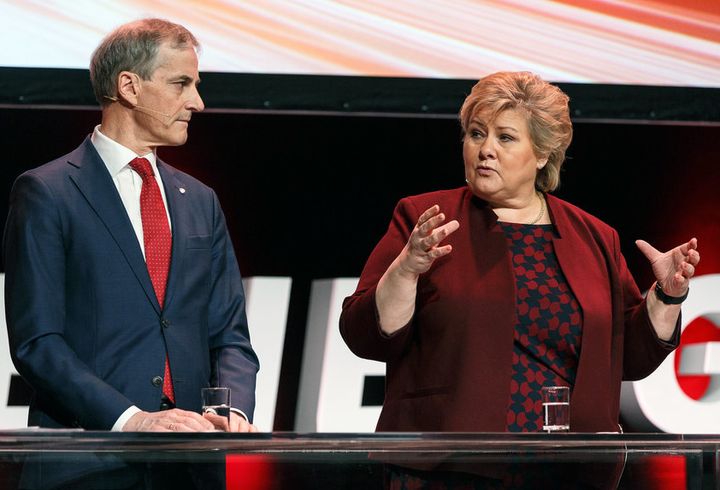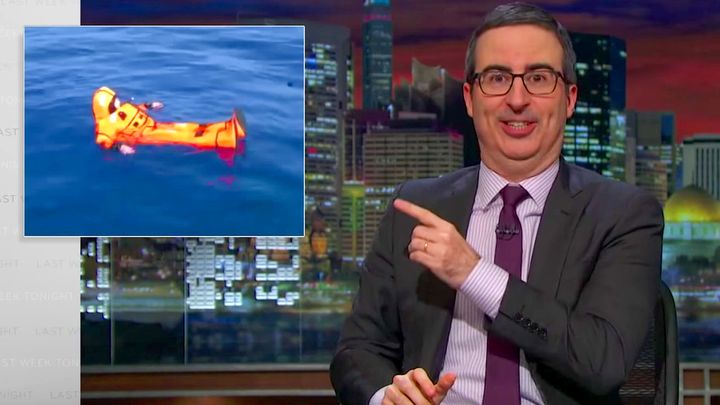
The leader of the Labor Party and PM-candidate Jonas Gahr Støre (left) hopes to replace Conservative PM Erna Solberg in next week’s elections in Norway.
Confusion reigns a few days before Norway's general election.
On September 11th, Norwegians head to the polls to elect a new government and parliament. A few days ahead of the vote, wildly diverging poll numbers have left experts, voters and politicians bewildered.
During the last four years, the Conservative Party has governed through a minority coalition with Norway's populist, and some would say right-wing, Progress Party. In previous election cycles, other parties had shunned the rambunctious populists. In 2013 however, the Conservative Party leader Erna Solberg joined forces with her rival to the right, Siv Jensen, and negotiated an agreement that depends on parliamentary support from the Liberal Party and the Christian Democrats.
While the Conservatives and the Progress Party have filled the cabinet, the four parties together form a parliamentary majority based on a mutually agreed platform, and agree on yearly budgets. Aside from this, the Liberals and the Christian Democrats act on their own accord, and have at times looked more like opposition parties than supporting partners.
It’s the Economy, Stupid!
In 2014, the sudden drop in oil prices left parts of Norway’s economy reeling, resulting in a restructuring of the oil and gas sector. Thousands lost their jobs, followed by sluggish economic growth. Inequality has been on the rise for quite some time, amplified, some say, by tax cuts benefiting primarily high-income earners and the wealthy. The housing market, which has been booming for years, seems to have hit a rough patch. While labor force participation has been declining, the unemployment rate has shown signs of improvement in recent months. All in all, economic indicators, though still ambiguous, seem to be pointing upwards.
Norway’s main opposition party, Labor, appears to have been caught off guard by the improving economic numbers. After the popular former leader, Jens Stoltenberg, took the reins at NATO, a former Foreign Minister and Minister of Health, Jonas Gahr Støre assumed the mantle at Labor. Støre launched his campaign by attacking the government for failing to address the bleak economic picture, while simultaneously promising a $2 billion tax hike to finance expanded welfare programs.
Early on, the confident opposition leader enjoyed a whopping 40 percent in the polls, but by spring the support had dropped to around 33 percent. Since then, the race has tightened considerably. In August, the Labor Party has seen support as low as 25 percent – and on several occasions, the center-right-wing block maintains its majority. In some polls, the Conservatives have even topped its historic rival. Should this be the case on election day, it would yield a result not seen in almost a century.

The current government is backed by the Christian Democrats and the Liberals. On the left, the head of the CD Knut Arild Hareide, next to Finance Minister Siv Jensen from the Progress Party, the PM, and the head of the Liberal Party, Trine Skei Grande.
An Election About Nothing
A week before the election, a staggeringly high number of voters remain undecided. In recent polls, 900.000 out of the 3.6 million eligible voters say they have yet to pick a party. The number, which normally drops in the weeks before the election, has actually increased as of late.
One explanation for the indecisiveness may be a lackluster political debate. In many ways, the election seems to have been focused on all but the issues. Some blame the Progress Party’s Minister of Immigration and Integration, Sylvi Listhaug, at times dubbed as “Norway’s Donald Trump”. With a formidable social media presence and well-planned statements intended to shock and provoke the left, Listhaug has dominated headlines. In fact, she is the third most cited politician after Mr. Støre and Ms. Solberg - despite the fact that she is not even the leader of the Progress Party.

Sylvi Listhaug made waves even outside of Norway last year. On his popular show “Last Week Tonight”, the host John Oliver dubbed the minister “an Aquatic Cheeto”
The controversial statements may still haunt the controversial minister’s own party though. After two years of supporting a diametrical view on refugees and immigrants, the Christian Democrats seem to have tired of Listhaug’s many antics. Instead, the party has campaigned on a promise of a coalition with the Conservatives and the Liberal Party, with tacit support from the Progress Party.
A few days before the election, this approach seems like a pipe dream, many say. In order to compete for seats-at-large, the parties must win 4 percent of the national vote. If either the Liberal Party or Christian Democrats fall under that threshold - not an unthinkable scenario - the center-right-wing block will most likely lose its majority. Moreover, having tasted the fruits of power, the Progress Party seems reluctant to support an alternative where it does not stay in government. Thus, the four coalition partners may be forced to continue their rocky marriage, should the numbers swing their way.
September Surprise?
In one recent poll, six out of ten voters said that they think Prime Minister Solberg will keep her job. Mr. Støre could still pull out a victory though. The Labor Party is known for its impressive “Get out the vote” operation. Moreover, Mr. Støre potential coalition partners, the Socialist Left Party and the Agrarian Party have shown potential to exceed expectations on election day. The Green Party, not likely to join a government on either side, may also end up tipping the scales in favor of the left by extracting concessions on fossil fuel extraction.
Less than a week before Norway’s parliamentary election, only one thing is certain: nothing is decided yet.
Sigrid Hagerup Melhuus, advisor at the think tank Agenda, co-authored this report with the byline author.
